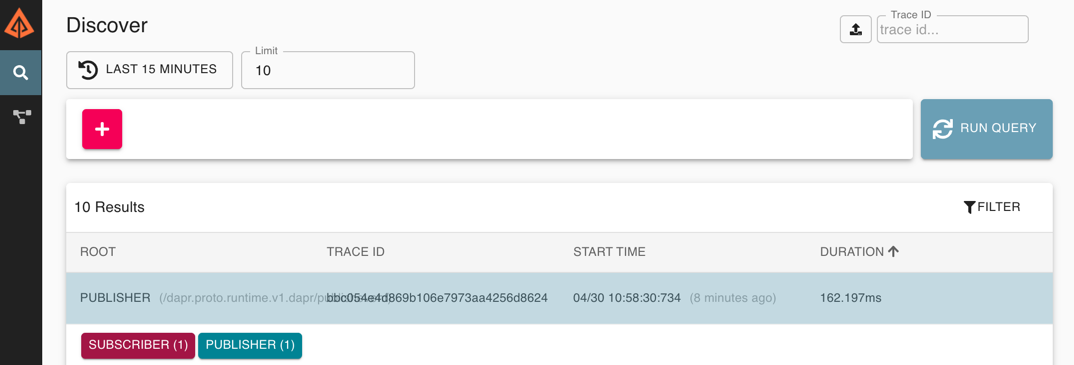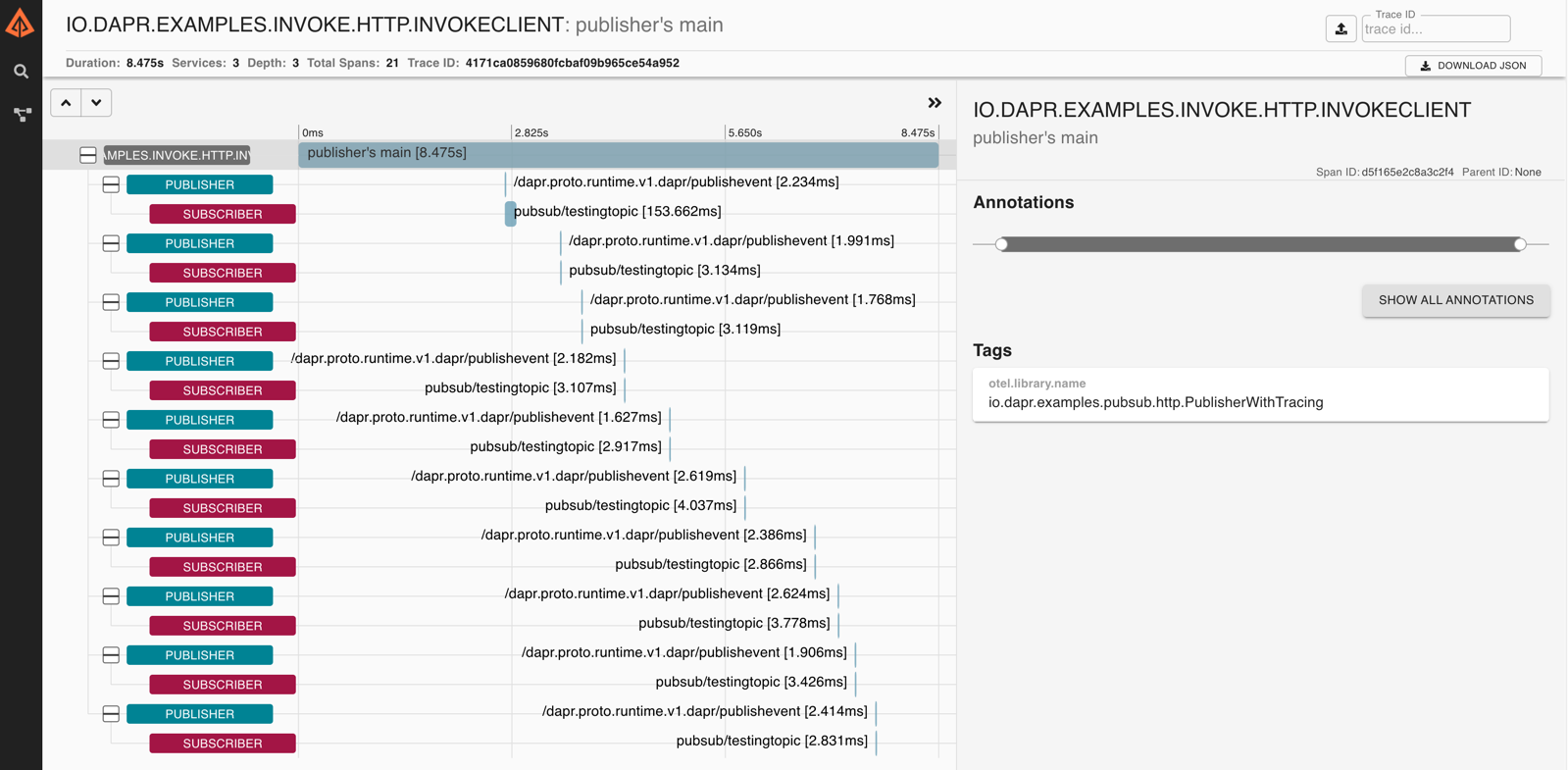In this sample, we'll create a publisher and a subscriber java applications using Dapr, based on the publish-subcribe pattern. The publisher will generate messages of a specific topic, while subscriber will listen for messages of specific topic. See Why Pub-Sub to understand when this pattern might be a good choice for your software architecture.
Visit this link for more information about Dapr and Pub-Sub.
This sample uses the HTTP Client provided in Dapr Java SDK for subscribing, and Dapr Spring Boot integration for publishing. This example uses Redis Streams (enabled in Redis versions => 5).
- Dapr and Dapr Cli.
- Java JDK 11 (or greater):
- Apache Maven version 3.x.
Clone this repository:
git clone https://github.com/dapr/java-sdk.git
cd java-sdkThen build the Maven project:
# make sure you are in the `java-sdk` directory.
mvn installThen get into the examples directory:
cd examplesThe first is the subscriber. It will subscribe to the topic to be used by the publisher and read the messages published. The Subscriber uses the Spring Boot´s DaprApplication class for initializing the SubscriberController. In Subscriber.java file, you will find the Subscriber class and the main method. See the code snippet below:
public class Subscriber {
public static void main(String[] args) throws Exception {
///...
// Start Dapr's callback endpoint.
DaprApplication.start(port);
}
}DaprApplication.start() Method will run an Spring Boot application that registers the SubscriberController, which exposes the message retrieval as a POST request. The Dapr's sidecar is the one that performs the actual call to the controller, based on the pubsub features.
This Spring Controller handles the message endpoint, printing the message which is received as the POST body.
The subscription's topic in Dapr is handled automatically via the @Topic annotation - which also supports the same expressions in
Spring's @Value annotations.
The code snippet below shows how to create a subscription using the @Topic annotation showcasing expression support. In this case, myAppProperty is a Java property that does not exist, so the expression resolves to the default value (messagebus).
@RestController
public class SubscriberController {
///...
@Topic(name = "testingtopic", pubsubName = "${myAppProperty:messagebus}")
@PostMapping(path = "/testingtopic")
public Mono<Void> handleMessage(@RequestBody(required = false) byte[] body,
@RequestHeader Map<String, String> headers) {
return Mono.fromRunnable(() -> {
try {
// Dapr's event is compliant to CloudEvent.
CloudEventEnvelope envelope = SERIALIZER.deserialize(body, CloudEventEnvelope.class);
String message = envelope.getData() == null ? "" : envelope.getData();
System.out.println("Subscriber got message: " + message);
} catch (Exception e) {
throw new RuntimeException(e);
}
});
}
}Execute the follow script in order to run the Subscriber example:
dapr run --components-path ./components/pubsub --app-id subscriber --app-port 3000 -- java -jar target/dapr-java-sdk-examples-exec.jar io.dapr.examples.pubsub.http.Subscriber -p 3000The other component is the publisher. It is a simple java application with a main method that uses the Dapr HTTP Client to publish 10 messages to an specific topic.
In the Publisher.java file, you will find the Publisher class, containing the main method. The main method declares a Dapr Client using the DaprClientBuilder class. Notice that this builder gets two serializer implementations in the constructor: One is for Dapr's sent and recieved objects, and second is for objects to be persisted. The client publishes messages using publishEvent method. The Dapr client is also within a try-with-resource block to properly close the client at the end. See the code snippet below:
Dapr sidecar will automatically wrap the payload received into a CloudEvent object, which will later on parsed by the subscriber.
public class Publisher {
private static final int NUM_MESSAGES = 10;
private static final String TOPIC_NAME = "testingtopic";
private static final String PUBSUB_NAME = "messagebus";
///...
public static void main(String[] args) throws Exception {
//Creating the DaprClient: Using the default builder client produces an HTTP Dapr Client
try (DaprClient client = new DaprClientBuilder().build()) {
for (int i = 0; i < NUM_MESSAGES; i++) {
String message = String.format("This is message #%d", i);
//Publishing messages
client.publishEvent(PUBSUB_NAME, TOPIC_NAME, message).block();
System.out.println("Published message: " + message);
//...
}
///...
}
}
}The CloudEventPublisher.java file shows how the same can be accomplished if the application must send a CloudEvent object instead of relying on Dapr's automatic CloudEvent "wrapping".
In this case, the app MUST override the content-type parameter via withContentType(), so Dapr sidecar knows that the payload is already a CloudEvent object.
public class Publisher {
///...
public static void main(String[] args) throws Exception {
//Creating the DaprClient: Using the default builder client produces an HTTP Dapr Client
try (DaprClient client = new DaprClientBuilder().build()) {
for (int i = 0; i < NUM_MESSAGES; i++) {
CloudEvent cloudEvent = new CloudEvent();
cloudEvent.setId(UUID.randomUUID().toString());
cloudEvent.setType("example");
cloudEvent.setSpecversion("1");
cloudEvent.setDatacontenttype("text/plain");
cloudEvent.setData(String.format("This is message #%d", i));
//Publishing messages
client.publishEvent(
new PublishEventRequestBuilder(PUBSUB_NAME, TOPIC_NAME, cloudEvent)
.withContentType(CloudEvent.CONTENT_TYPE)
.withMetadata(singletonMap(Metadata.TTL_IN_SECONDS, MESSAGE_TTL_IN_SECONDS))
.build()).block();
System.out.println("Published cloud event with message: " + cloudEvent.getData());
//...
}
//...
}
}
}Use the follow command to execute the Publisher example:
dapr run --components-path ./components/pubsub --app-id publisher -- java -jar target/dapr-java-sdk-examples-exec.jar io.dapr.examples.pubsub.http.PublisherOnce running, the Publisher should print the output as follows:
✅ You're up and running! Both Dapr and your app logs will appear here.
== APP == Published message: This is message #0
== APP == Published message: This is message #1
== APP == Published message: This is message #2
== APP == Published message: This is message #3
== APP == Published message: This is message #4
== APP == Published message: This is message #5
== APP == Published message: This is message #6
== APP == Published message: This is message #7
== APP == Published message: This is message #8
== APP == Published message: This is message #9
== APP == Done.
Messages have been published in the topic.
Once running, the Subscriber should print the output as follows:
== APP == Subscriber got: This is message #3
== APP == Subscriber got: {"id":"1f646657-0032-4797-b59b-c57b4f40743b","source":"publisher","type":"com.dapr.event.sent","specversion":"1.0","datacontenttype":"application/json","data":"This is message #3","expiration":"2020-12-24T05:29:12Z"}
== APP == Subscriber got: This is message #8
== APP == Subscriber got: {"id":"a22b97ce-9008-4fba-8b57-c3c3e1f031b6","source":"publisher","type":"com.dapr.event.sent","specversion":"1.0","datacontenttype":"application/json","data":"This is message #8","expiration":"2020-12-24T05:29:15Z"}
== APP == Subscriber got: This is message #0
== APP == Subscriber got: {"id":"abb2f110-6862-49f7-8c8d-189f6dcd177d","source":"publisher","type":"com.dapr.event.sent","specversion":"1.0","datacontenttype":"application/json","data":"This is message #0","expiration":"2020-12-24T05:29:11Z"}
== APP == Subscriber got: This is message #7
== APP == Subscriber got: {"id":"043f31d3-c13a-4a02-ac89-64ecca946598","source":"publisher","type":"com.dapr.event.sent","specversion":"1.0","datacontenttype":"application/json","data":"This is message #7","expiration":"2020-12-24T05:29:14Z"}
== APP == Subscriber got: This is message #2
== APP == Subscriber got: {"id":"acc554f4-7109-4c31-9374-0e5936b90180","source":"publisher","type":"com.dapr.event.sent","specversion":"1.0","datacontenttype":"application/json","data":"This is message #2","expiration":"2020-12-24T05:29:12Z"}
== APP == Subscriber got: This is message #9
== APP == Subscriber got: {"id":"8b3ad160-368d-4b0f-9925-8fa2a2fbf5ca","source":"publisher","type":"com.dapr.event.sent","specversion":"1.0","datacontenttype":"application/json","data":"This is message #9","expiration":"2020-12-24T05:29:15Z"}
== APP == Subscriber got: This is message #1
== APP == Subscriber got: {"id":"e41d4512-511a-4a2b-80f3-a0a4d091c9a5","source":"publisher","type":"com.dapr.event.sent","specversion":"1.0","datacontenttype":"application/json","data":"This is message #1","expiration":"2020-12-24T05:29:11Z"}
== APP == Subscriber got: This is message #4
== APP == Subscriber got: {"id":"33e21664-128e-4fc4-b5c4-ed257f758336","source":"publisher","type":"com.dapr.event.sent","specversion":"1.0","datacontenttype":"application/json","data":"This is message #4","expiration":"2020-12-24T05:29:13Z"}
== APP == Subscriber got: This is message #6
== APP == Subscriber got: {"id":"bd14f1ee-ca6b-47f7-8130-dd1e6de5b03c","source":"publisher","type":"com.dapr.event.sent","specversion":"1.0","datacontenttype":"application/json","data":"This is message #6","expiration":"2020-12-24T05:29:14Z"}
== APP == Subscriber got: This is message #5
== APP == Subscriber got: {"id":"acc57cd6-71da-4ba3-9a12-9c921ca49af7","source":"publisher","type":"com.dapr.event.sent","specversion":"1.0","datacontenttype":"application/json","data":"This is message #5","expiration":"2020-12-24T05:29:13Z"}
Messages have been retrieved from the topic.
Dapr handles tracing in PubSub automatically. Open Zipkin on http://localhost:9411/zipkin. You should see a screen like the one below:
Click on the search icon to see the latest query results. You should see a tracing diagram similar to the one below:
Once you click on the tracing event, you will see the details of the call stack starting in the client and then showing the service API calls right below.
If you would like to add a tracing span as a parent of the span created by Dapr, change the publisher to handle that. See PublisherWithTracing.java to see the difference and run it with:
dapr run --components-path ./components/pubsub --app-id publisher_tracing -- java -jar target/dapr-java-sdk-examples-exec.jar io.dapr.examples.pubsub.http.PublisherWithTracingNow, repeat the search on Zipkin website. All the publisher and subscriber spans are under the same parent span, like in the screen below:
Optionally, you can see how Dapr can automatically drop expired messages on behalf of the subscriber.
First, make sure the publisher and the subscriber applications are stopped.
Then, change the TTL constant in the Publisher.java file from:
private static final String MESSAGE_TTL_IN_SECONDS = "1000";To:
private static final String MESSAGE_TTL_IN_SECONDS = "1";Now rebuild the example:
mvn installRun the publisher app:
dapr run --components-path ./components/pubsub --app-id publisher -- java -jar target/dapr-java-sdk-examples-exec.jar io.dapr.examples.pubsub.http.PublisherWait until all 10 messages are published like before, then wait for a few more seconds and run the subscriber app:
dapr run --components-path ./components/pubsub --app-id subscriber --app-port 3000 -- java -jar target/dapr-java-sdk-examples-exec.jar io.dapr.examples.pubsub.http.Subscriber -p 3000No message is consumed by the subscriber app and warnings messages are emitted from Dapr sidecar:
== DAPR == time="2020-12-23T21:21:59.085797-08:00" level=warning msg="dropping expired pub/sub event 461546c1-d2df-42bd-a6b8-3beeb952fe1e as of 2020-12-24T05:21:50Z" app_id=subscriber instance=myhost scope=dapr.runtime type=log ver=edge
== DAPR == time="2020-12-23T21:21:59.085841-08:00" level=warning msg="dropping expired pub/sub event 2d8cf9a6-4019-4dda-95fd-59218a19381b as of 2020-12-24T05:21:48Z" app_id=subscriber instance=myhost scope=dapr.runtime type=log ver=edge
== DAPR == time="2020-12-23T21:21:59.085871-08:00" level=warning msg="dropping expired pub/sub event d2a199e0-a4b8-4067-9618-6688391ad68f as of 2020-12-24T05:21:53Z" app_id=subscriber instance=myhost scope=dapr.runtime type=log ver=edge
== DAPR == time="2020-12-23T21:21:59.085894-08:00" level=warning msg="dropping expired pub/sub event 30719f17-ad8f-4dea-91b5-b77958f360d4 as of 2020-12-24T05:21:49Z" app_id=subscriber instance=myhost scope=dapr.runtime type=log ver=edge
== DAPR == time="2020-12-23T21:21:59.085797-08:00" level=warning msg="dropping expired pub/sub event d136d5ae-5561-418c-a850-9d1698bc8840 as of 2020-12-24T05:21:51Z" app_id=subscriber instance=myhost scope=dapr.runtime type=log ver=edge
== DAPR == time="2020-12-23T21:21:59.085958-08:00" level=warning msg="dropping expired pub/sub event 82b334a2-e295-48ea-8c6c-c45b1c4fcd2d as of 2020-12-24T05:21:50Z" app_id=subscriber instance=myhost scope=dapr.runtime type=log ver=edge
== DAPR == time="2020-12-23T21:21:59.085973-08:00" level=warning msg="dropping expired pub/sub event f6eb3f9f-185f-492f-9df9-45af8c91932b as of 2020-12-24T05:21:53Z" app_id=subscriber instance=myhost scope=dapr.runtime type=log ver=edge
== DAPR == time="2020-12-23T21:21:59.086041-08:00" level=warning msg="dropping expired pub/sub event a536eb9f-34e0-49fc-ba29-a34854398d96 as of 2020-12-24T05:21:52Z" app_id=subscriber instance=myhost scope=dapr.runtime type=log ver=edge
== DAPR == time="2020-12-23T21:21:59.085995-08:00" level=warning msg="dropping expired pub/sub event 52cc9528-f9d4-44f4-8f78-8f32341a743a as of 2020-12-24T05:21:49Z" app_id=subscriber instance=myhost scope=dapr.runtime type=log ver=edge
== DAPR == time="2020-12-23T21:21:59.085797-08:00" level=warning msg="dropping expired pub/sub event 7cf927e8-e832-4f8a-911a-1cae5a1369d2 as of 2020-12-24T05:21:48Z" app_id=subscriber instance=myhost scope=dapr.runtime type=log ver=edge
For more details on Dapr Spring Boot integration, please refer to Dapr Spring Boot Application implementation.
dapr stop --app-id publisher
dapr stop --app-id subscriber


